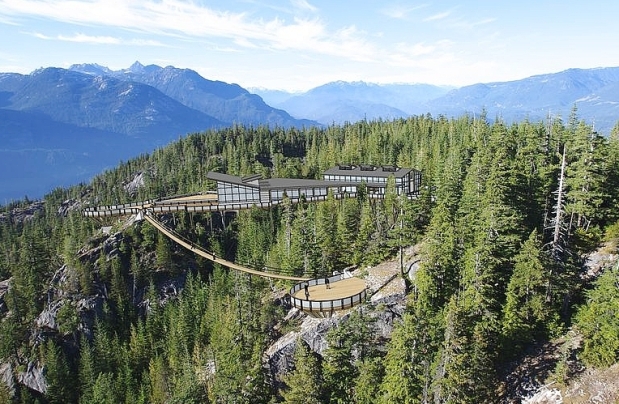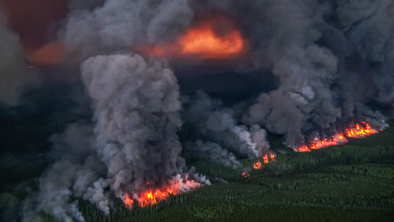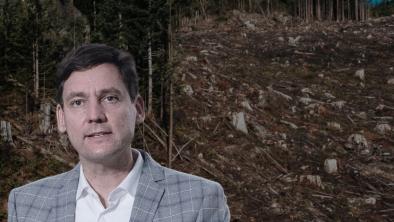Squamish’s Sea to Sky Gondola project gears up for a spring opening
Vancouver Sun

A Squamish gondola project that some tourism analysts are calling B.C.’s top new attraction for 2014 is on track to open in May, the developers have announced.
The $22-million Sea to Sky Gondola project, just south of the Stawamus Chief, should attract over 200,000 visitors in its first year, while enhancing Squamish’s reputation as an outdoor recreation mecca.
“The gondola itself is just one component,” said Jayson Faulkner, general manager and a founding partner of the project. He said the project is a good fit for Squamish, which calls itself the Outdoor Recreation Capital of Canada. “It’s a much bigger facility, with a lot of other amenities.”
Bored with Grouse Mountain’s gruelling Grind? Get ready for a new ‘GrindTrail’ for the hardiest of hikers that’s planned to open in 2015 as part of the project.
Proponents promise it will take hikers up 853 vertical metres on a 2.5-kilometre trail to a 9,000-square-foot lodge — also opening next spring — where they can have a beer and a burger on a large deck overlooking Howe Sound.
“There will be a restaurant, group private function facility, café, retail and a spectacular deck,” Faulkner said. “Out on the deck will be the place to go to watch the sun go down with a glass of wine.
Hikers can then take one of the 20 Swiss-made Dopplemayr eight-person gondolas back down. “The only hitch we’ve had, which was a surprise, was the snow load,” Faulkner said. “We had to double the size of beams and our construction cost of the upper facility to accommodate a seven-metre snow load.”
A 110-metre-long suspension bridge at the summit with 360-degree views of Howe Sound below is almost complete but will open with the gondola and lodge.
“It spans a ravine, but it’s different because you’re on the side of a mountain and all the terrain falls away below you. So it’s very dramatic. You can see all the way down Howe Sound. There’s spectacular views all the way to Whistler, Mount Garibaldi, with a very alpine feel to it.”
The project also includes cross-country skiing trails, backcountry skiing, snowshoeing, mountain bike trails, and several kilometres of hiking trails at the summit.
“At the top, we’ve got multiple trails, including two interpretative trails, a suspension bridge, and two viewing platforms, one with a very significant cantilevered platform about 300 feet in the air. And there will be trail systems accessing the upper reaches of the Upper Shannon watershed, accessing both the Mount Habrich and Skypilot mountains,” Faulkner said.
“It’s about creating access to this whole other world of outdoor activities, but non-motorized.
The gondola pricing has not yet been released, but “it will be competitive.” As at Grouse, using the Grind will be free, but users will have to pay to take the gondola down.
“This is probably the hottest new product to attract visitors to B.C., and our region in particular, next year,” said Kevan Ridgway, president and CEO of Vancouver Coast and Mountains Tourism Region, one of six regional destination marketing organizations for B.C.
“We’ve been promoting it already to international tour operators that we met with in May. On Tuesday we’re presenting it to people who are based here and work with tour operators from around the world.
“It will be unique. It’s not a gondola leading to a ski hill, so it’s not competing with Whistler. It will attract people who are stopping at Shannon Falls now and give them another reason to stay longer and do more. The viewscapes from the top of The Chief over Howe Sound are pretty spectacular and that’s what visitors are looking for.”
Ridgway also said the project fits well with the new Squamish.
“What we’ve seen over the last few years, certainly the last couple of years, is an energy around the Squamish community. It started with redeveloping the West Coast Railway Park, then the Britannia Mine museum was totally renovated.
We see the Sea to Sky Gondola as a further addition to the products available in the Squamish area.
“I think Squamish is a community that’s really developing and growing, particularly from a tourism point of view.
There will be a new waterfront development in Squamish as well.”
Faulkner said that while the GrindTrail won’t open until the project’s second phase, likely in 2015, an existing trail goes to the summit but is much longer and rougher than what’s planned.
The new trail — a direct route to the summit — will take hikers through terrain that includes steep granite cliffs and outcrops to first growth forest and open sub-alpine areas, with views to Howe Sound and the Coastal Mountain range.
“People love the exercise and the nice thing here is you can get up to the top, have a burger and beer or a glass of wine, look at a spectacular view and then ride the lift down.”
There will also be 60 to 70 full-time jobs, he said, mostly for Squamish residents.
“We wanted the local community to take ownership of this,” he said. “That’s one of the reasons we’ve seen so much support locally. They see this as a tremendous asset for Squamish, helping to establish Squamish as a destination for tourism and outdoor adventure.
There was controversy when the project got underway with some environmental groups including the Wilderness Committee and the Sierra Club criticizing the process for getting approval, saying there wasn’t enough public consultation in removing 2.36 hectares from Stawamus Chief Provincial Park.
Others felt it was too close to The Chief and might detract from both the park and the granite monolith’s climbing experience.
However, the community was largely supportive, including other environmentalists.
For example, Edith Tobe, executive director of the Squamish Watershed Society, wrote in a letter to The Vancouver Sun in 2012 that she loved the idea of the project “bringing eco-friendly tourism to Squamish that would be available to people of every physical ability.”
Meanwhile, Tourism Industry Association of B.C. chair Christine Stoneman believes the project is a good fit for B.C., not just Squamish.
Local businesses will see a spinoff effect. “Anytime you drive tourists to any destination, there will always be benefits from the gas station that might be busier, to the restaurants to other attractions, even something like the local drugstore that they’ll stop in.”
Sea to Sky Gondola Corp. says its principals have overseen many large tourism projects and are now specializing in community and resort development projects in the Sea to Sky Corridor. Through their development services company, GroundEffects Development Inc., they have been involved in the Squamish Oceanfront Development Corporation, the new proposed Coast Mountain Academy in Squamish, and Whistler Olympic Park in the Callaghan Valley.


